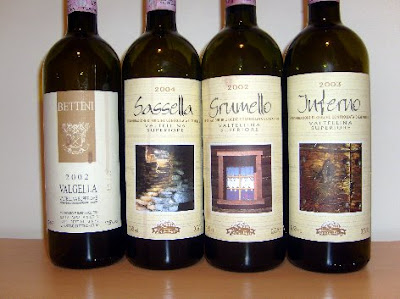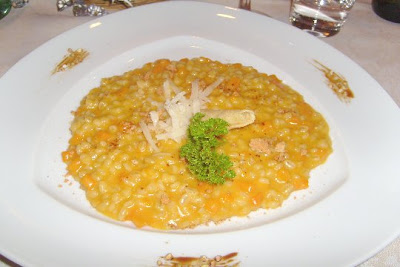The day: 13th February 2007, Dinner.
The place: Via Don Arcangelo Rizzi, 11,
The venue: Osteria Le Due Spade
The food: Fine Italian Dining, with strong regional influence
The drinks: Extensive list, several regional wines but also many other choices, all prices. No list by the glass, but they said they would open almost anything (not Sassicaia)

The single dining room is divided in two parts, a warm wood panelled front and a plastered back part which gives a cellar feel with its vaulted low ceiling. They say it can accommodate up to 30 diners, but we wouldn’t want to be there in that case – on our night the 19 covers were just about well spaced. In the summer you can dine ‘al fresco’ under a semi-private pergola on the pavement (and if you wish you can look at spaced out students coming out of their lectures ![]() )
)
We were greeted by a complimentary glass of Prosecco Colesel Riserva.
Chef Federico Parolari proposes a very varied and enticing menu, which seems equally strong on fish (their speciality) and non-fish dishes. There are four set menus (‘creative’, ‘regional’ and ‘artichokes’ at €60, €50 and €45, respectively, and a €25 one course plus coffee lunch menu). The separate a la carte offering is equally tempting. Among the starters (all within €14) we noticed a seafood ‘trilogy’ (crayfish in crispy batter, scallops in artichoke tart and stewed octopus); and a raw trio of tuna tartare, seabream with pink pepper and passion fruit marinated prawns. Primi (€16) included a home made squid ink fettuccine with shellfish and corn fettuccine in rabbit ragout. Mains (all within €20) highlights included suckling pig fillet with Polenta di Storo and cheese fondue with black truffles.
Man ordered ‘Salt-cod variation’ and baked seabream in chickpea puree and Garda extra-virgin olive oil from the a la carte menu. Woman (in the knowledge that, as always, she would share everything with Man) chose the artichoke menu (the English translation is a bit hit and miss but we’ll help you as we go along). Just in case you don’t know, artichokes are now in season.
This ordering was not straightforward. The very pushy front manager oddly insisted that Man ordered a dessert straightaway (first time ever this occurs to us). Man said he wasn’t sure he was going to have a dessert. Front man insisted it was crucial Man decided now. Man fought him off valiantly, egged on by Woman’s sympathetic look, until Front man agreed to mark a dessert down ‘provisionally’ just in case Man decided to have it in the end.
While recovering from the fight, the bread basket…wait a minute, it’s not just a basket, but a beautiful copper pot more traditionally used to cook polenta over a wood fire. How nice! Here the candle was enough to keep the bread warm:
Attention and creativity in the layout will be a nice recurring theme here. The bread was focaccia, grissini and white rolls, not a spectacular assortment, but OK, very similar indeed to the Scrigno two minutes walk away (same bakery?).
Complimentary vegetable dumplings come to keep company to the Prosecco:
Puff pastry stuffed full with cabbage, aubergines and sprinkled with poppy seeds. An intriguing and good start, with a powdered tomato skin on the side lending a pleasantly bitter note to the sweetish dumplings.
At this point a new offensive by Front man: has Man decided about the dessert? This surprise attack almost succeeded but no, Man hasn’t decided…can we not wait to the end as in any other place?
The salt-cod variations arrives at the same time as the artichoke and squid soup:
As for the Baccala' variations, proceeding left to right in the picture, the first variation had the cod stewed in its own cooking juices (or perhaps even steamed we conjecture) with just some pine-nuts and raisins added. This was soft and delicate to the point of being almost bland. Pleasant, especially when judged in the context of the coming progression. For the second variation, imagine a savoury cod baba’ (spongy cake) in a cheese sauce: truly excellent, both for the consistency and the flavour. The third variation was stewed in a rich tomato sauce and accompanied by polenta. This was slightly woodier and drier to the bite, but tasting very good nonetheless. Overall a well conceived and well presented dish.
The soup, as you can see, came in a bowl all smudged on one side. Apart from this detail (which Man finds unappetising) the only problem was that it was too salty. The broth was beautifully infused with the earthy flavour of the artichoke wedges and potato cubes, and with the sea-flavour of the tender squid. Comfort food, classy style.
At this point the artichoke cake came on its own for sharing.
On the left in the picture is layers of potato and artichokes (not puff pastry as in the English language menu) sitting on an artichoke puree and topped by melted cheese (unfortunately we do not know which one nor did Front man tell us). On the right, four slices of wild boar cured ham (‘speck’). With impressive colours and nicely presented (though what was the fried spaghetto, same as in previous dish, doing there?), they were both supremely good (the only problem for Woman was again too much salt in both). The potatoes borrowed the flavour from the artichokes and thus prolonging the pleasure. The raw ingredients must have been very first quality.
The mains:
Do you see a certain similarity in the dishes? You are right, the garnishes had 80% overlap. To be honest, the presentation looked sumptuous but messy and confusing here, a veritable garden, with a large array of dollops of various vegetables, and as we said, largely the same for two very different mains. Indeed the bream clashed with some of the garnish, and its flavour came out losing the battle. Some of the sides were once again too salty, especially the carrots and the caponata (aubergines in rich tomato sauce, capers, etc.).
The lamb arrived just warm. Particularly bad luck for Man, who was the second to share. These were four chops, not stuffed as in the official English description, but accompanied by a julienne of fried artichoke leaves. Very good and again prime quality, cooked pink to perfection, though a small portion in a very big and not warm enough plate is not psychologically conducive to ecstasy.
Man has finally decided. He will skip dessert but will have a Vin Santo (local dessert wine). When he informs a waiter (not Front man), guess what, we are told that according to the order list Man has already ordered dessert…Man says no (a point of principle by now) and worries whether the ‘due spade’ (two swords) are meant for duels between unyielding customers and Front man…Anyway Man must have had a rather pissed off look, as after a couple of minutes Front man arrived with an apologetic look to clarify that indeed the dessert was written down, but with a question mark near it! That’s all right then.
The symphony is a chocolate and pear cake accompanied by pear sorbet, chocolate sauce and the pear shape that you see in the middle of the picture is a pear puree. Nicely playful presentation. Tastewise, it was good, though the chocolate flavour was perhaps a bit muted. All in all though a balanced, pleasant dessert. Man had a glass of Pravis Arele 1995 Vin Santo (€5), poured with extreme generosity by a nice waiter. This is a wine made from Nosiola grapes, left to dry on ‘graticci’. Amber orange colour, dominant honey flavour and pleasantly dense.
Water was two half litre bottle at €2. No large bottle was available! For wine we had a local Chardonnay Cesconi 2005 at €20. The bill came to €108.
The selection of complimentary petit fours which came in the end was probably the most impressive we have experienced so far:
Great range: mini frappe (typical deep fried pastry common over the Carnival period); various chocolates, ricotta cannoli and chococolate cannoli, fruit tarts, coconut madeleines; home-made cantuccini; and baci di dama. All delicious.
We had mixed impressions of this place. Most things coming from the kitchen struck us as impressive, well conceived, executed, and presented (even if with some repetitiveness, excess saltiness, loss of control and corrections to be made in a couple of dishes). In view of this, the comically open commercialism and pushiness of the front manager looked surprising and out of context, not worthy of the establishment that this aims to, and can, be. If we were the chef, we would be appalled. We also note that the white wine did not come in a cooling bucket and by the end it was almost undrinkable (in fact we left some): this, too, must be laid at the door of the front manager. A pity, because the cuisine and the physical environment strike a nice mixture between simplicity and sophistication. There are many other dishes we would like to try here: what is the manager’s day off?
















































